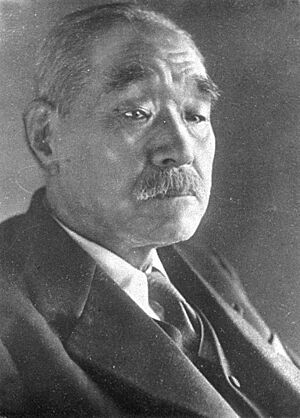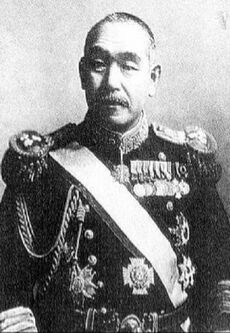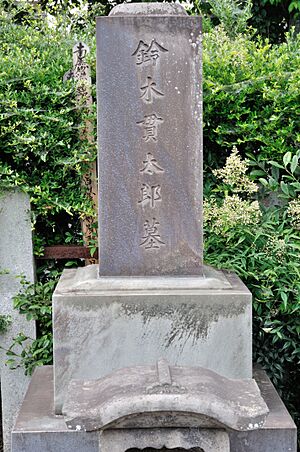Kantarō Suzuki facts for kids
Quick facts for kids
Kantarō Suzuki
|
|
|---|---|
|
鈴木 貫太郎
|
|

Suzuki c. 1940s
|
|
| Prime Minister of Japan | |
| In office 7 April 1945 – 17 August 1945 |
|
| Monarch | Hirohito |
| Preceded by | Kuniaki Koiso |
| Succeeded by | Naruhiko Higashikuni |
| President of the Privy Council | |
| In office 15 December 1945 – 13 June 1946 |
|
| Monarch | Hirohito |
| Vice President | Shimizu Tōru |
| Preceded by | Hiranuma Kiichirō |
| Succeeded by | Shimizu Tōru |
| In office 10 August 1944 – 7 April 1945 |
|
| Monarch | Hirohito |
| Vice President | Shimizu Tōru |
| Preceded by | Yoshimichi Hara |
| Succeeded by | Hiranuma Kiichirō |
| Vice President of the Privy Council | |
| In office 24 June 1940 – 10 August 1944 |
|
| Monarch | Hirohito |
| President | Yoshimichi Hara |
| Preceded by | Yoshimichi Hara |
| Succeeded by | Shimizu Tōru |
| Personal details | |
| Born | 18 January 1868 Kuze, Izumi Province, Empire of Japan |
| Died | 17 April 1948 (aged 80) Noda, Chiba Prefecture, Japan |
| Political party | Imperial Rule Assistance Association (1940–1945) |
| Other political affiliations |
Independent (Before 1940 and after 1945) |
| Spouse | Taka Adachi |
| Children | Hajime Suzuki |
| Relatives | Takao Suzuki (brother) Suguru Suzuki (nephew) |
| Alma mater | Imperial Japanese Naval Academy |
| Profession | Admiral, politician |
| Awards | Order of the Golden Kite (3rd class) |
| Signature |  |
| Military service | |
| Allegiance | |
| Branch/service | |
| Years of service | 1887–1929 |
| Rank | |
| Commands | Akashi, Soya, Shikishima, Tsukuba Maizuru Naval District, IJN 2nd Fleet, IJN 3rd Fleet, Kure Naval District, Combined Fleet |
| Battles/wars |
|
Baron Kantarō Suzuki (born January 18, 1868 – died April 17, 1948) was an important Japanese admiral and politician. He served in the Imperial Japanese Navy and was the last Prime Minister of Japan during World War II, from April to August 1945. He played a key role in Japan's decision to surrender and end the war.
Contents
Suzuki was born in Izumi Province (which is now part of Sakai, Osaka) on January 18, 1868. He grew up in Noda, Chiba Prefecture.
He joined the Imperial Japanese Naval Academy in 1884 and graduated in 1887. He served on several ships as a young officer. Suzuki became known as an expert in torpedo warfare.
Serving in Major Wars
Suzuki fought in the First Sino-Japanese War. He commanded a torpedo boat and took part in a night attack during the Battle of Weihaiwei in 1895. After this, he studied at the Naval Staff College. He also worked as a naval representative in Germany from 1901 to 1903.
During the Russo-Japanese War, Suzuki commanded a group of destroyers. He helped rescue survivors during the Battle of Port Arthur. He also served on the cruiser Kasuga in the Battle of the Yellow Sea. In the important Battle of Tsushima, his destroyers helped sink a Russian battleship.
After these wars, Suzuki continued to rise through the ranks. He commanded several ships, including destroyers, cruisers, and battleships. He became a rear admiral in 1913.
Suzuki served as Vice Minister of the Navy from 1914 to 1917, during World War I. He was promoted to vice admiral in 1917. He later became the head of the Imperial Japanese Naval Academy.
In 1923, he became a full admiral. The next year, he became the Commander in Chief of the Combined Fleet, which was the main fleet of the Imperial Japanese Navy. From 1925 to 1929, he was the Chief of the Imperial Japanese Navy General Staff. After retiring from active duty, he became a special advisor to the Emperor.
Surviving an Attack
In 1936, Suzuki was almost killed during an event known as the February 26 Incident. A bullet from the attack stayed in his body for the rest of his life. Suzuki was against Japan going to war with the United States, both before and during World War II.
Prime Minister of Japan
On April 7, 1945, at the age of 77, Suzuki became the Prime Minister of Japan. He also served as the Minister for Foreign Affairs.
Ending World War II
As Prime Minister, Suzuki played a crucial role in the peace talks with the Allied Powers to end World War II. He organized two special meetings with Emperor Hirohito. These meetings helped to solve disagreements within the Japanese government about the Potsdam Declaration, which called for Japan's unconditional surrender.
Suzuki explained the terms of surrender to Emperor Hirohito, who had already decided to accept them. This was a very difficult decision because many military leaders wanted to keep fighting. Some of these military leaders even tried to assassinate Suzuki twice on August 15, 1945, in an event called the Kyūjō Incident. They wanted to stop Japan from surrendering.
After Japan publicly surrendered, Suzuki resigned as Prime Minister. Prince Higashikuni Naruhiko became the next prime minister. Suzuki continued to serve as the Chairman of the Privy Council for a time after the war.
Suzuki passed away peacefully on April 17, 1948. He is buried in his hometown of Noda, Chiba.
Honours and Recognition
Suzuki received many honours during his life for his service to Japan.
- He was given the title of Baron in 1936.
- He received several important Japanese decorations, including the Order of the Sacred Treasure, the Order of the Golden Kite, the Order of the Rising Sun, and the Order of the Paulownia Flowers. These awards recognized his bravery and service to his country.
Images for kids







